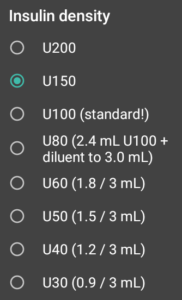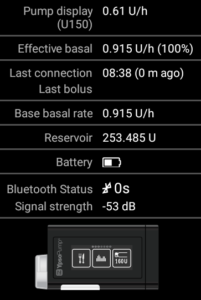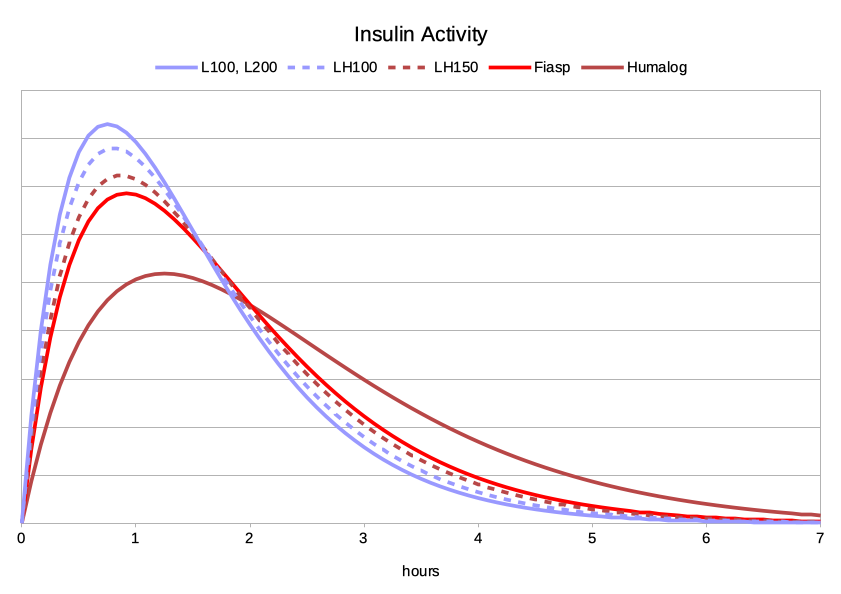I’ve reported previously about my experiences with insulin timings, including what happens when we go off-label and blend Humalog U100 with Lyumjev U100. I’ve now done another phase of experimentation, with a new data point. And some analysis of why these results might come about.
I’ll first rewind a bit and explain that Humalog / Lyumjev U100 mix again.
Lyumjev is generally available in two forms: U100 (in vials, pens, and pen cartridges) and U200 (in pens, just like Humalog U200). Their speed of action turns out to be the same:
| Shorthand name | Description | Density | Minutes to peak-activity | Accelerant per volume | Accelerant per U |
|---|---|---|---|---|---|
| L100 | Lyumjev U100 | U100 | 45 (“Lyumjev” plugin in AAPS) | 1 (reference) | 1 (reference) |
| L200 | Lyumjev U200 | U200 | 45 (“Lyumjev”) | 1 | 0.5 |
| H100 | Humalog U100 | U100 | 75 (“Rapid-Acting”) | 0 | 0 |
The actual concentration of accelerant in L100 is 1.06 µg/mL (and thus 10.6 ng/U) but I’ve simplified things in these tables to just scale that to “1” for comparison.
Very Off-Label!
Before you read further I should point out that this is a record of very OFF-LABEL experimentation!
I am not recommending that other people follow my examples.
But hopefully my observations might help expand understanding of the insulin behaviours.
Stinging
One of the issues people often report when they start using Lyumjev is the stinging. It seems that the treprostinil vasodilator which gives it the accelerated effect over Humalog is known for this.
The amount of treprostinil in the insulin is tiny, but just enough to have a significant difference on the speed of action. As you can see from the above table the amount of accelerant is the same by volume for both forms of Lyumjev, although we get half the amount for the same dose of insulin.
Anecdotal reports from European users indicated that even after transferring from pen into pump and adjusting the doses appropriately, the U200 form stung a lot less yet was just as effective. My own experience backs this up.
Of course, using U200 insulin in a pump approved for U100 use is quite off-label (largely due to the dangers of over-dosing) but the community is all about using what’s effective, even if it isn’t the approved system to the letter.
Obviously stinging (with any insulin) is more likely with larger boluses. By using an AID system that prefers many small doses rather than huge meal boluses, we can reduce the impact. But it can’t eliminate it.
But sometimes we get a site that Just Stings. Even with Humalog or NovoRapid. The best solution for those is to put a fresh site in somewhere else on the body.
Acclimation
Anecdotal feedback from people who infuse treprostinil via pump for diseases such as Parkinson’s Disease (an off-label treatment, but apparently with some efficacy) was that it stings. A LOT. Until the body gets used to it after a few months.
I’ve written about this before, but it’s worth a recap before describing the latest experiment.
I definitely noticed some stinging with Lyumjev U100. It seemed a reasonable idea to use U200 for as long as I could as this would at least be introducing the vasodilator in lower volumes, and then when I eventually used the U100 form maybe I would be “used to it”. Some people think of Mithridates when talk goes to acclimation, but I think that might be taking analogies a little far.
However, U200 was expensive and I didn’t have much of it, so I decided to try mixing Lyumjev U100 with Humalog U100 to form what I’ve been referring to as “LH100”. I’d used a similar routine with Fiasp (which has its own stinging issues) when it was introduced.
| Shorthand name | Description | Density | Minutes to peak-activity | Accelerant per volume | Accelerant per U |
|---|---|---|---|---|---|
| L100 | Lyumjev U100 | U100 | 45 (“Lyumjev” plugin) | 1 (reference) | 1 (reference) |
| L200 | Lyumjev U200 | U200 | 45 (“Lyumjev”) | 1 | 0.5 |
| LH100 | 1:1 L100+H100 |
U100 | 48 (“Free-peak”) | 0.5 | 0.5 |
As you can see here, the amount of accelerant per U of insulin is the same with LH100 as L200, although it’s a lower concentration by volume. This presumably is why the speed of action doesn’t seem to be the same.
I’ve previously reported that a peak time of 48 minutes has worked well for me with this blend. I also reported that when I eventually switched to straight L100 I no longer had as much stinging noticeable.
Mixing
Blending Humalog U100 and Lyumjev U100 is fairly straightforward. I draw up about half of the reservoir from one insulin and get rid of any bubbles. Then top it up with the other.
No matter the precise proportions, the result will always be U100. As long as I’m fairly consistent with the ratio then the concentration of accelerant won’t vary by much.
Economy
Mixing the insulins in the reservoir is a little more hassle than just the regular fill procedure. Although the way we pre-fill a series of reservoirs for the YpsoPump helps make it less of an issue.
But quite apart from the reduction in irritation, using half the volume of Lyumjev does double the lifespan of my expensive and limited Lyumjev supply. That made me consider continuing to do it long-term, as 48 minutes is still fast enough to let my no-announce fully-closed AID system excel!
Another experiment
Me being me, there’s always another experiment around the corner. I decided to try something new: LH150. By blending Lyumjev U100 in equal volume with Humalog U200 (so twice as many U from the Humalog) I get an interesting mixture.
As you can see in this table, the concentration of accelerant by volume is the same as LH100 so we might expect the time to peak activity might be the same. However it ended up being slightly longer (this was found through iterative testing over many weeks). Presumably because the concentration per unit of insulin is also reduced.
| Shorthand name | Description | Density | Minutes to peak-activity | Accelerant per volume | Accelerant per U |
|---|---|---|---|---|---|
| L100 | Lyumjev U100 | U100 | 45 (“Lyumjev” plugin) | 1 (reference) | 1 (reference) |
| L200 | Lyumjev U200 | U200 | 45 (“Lyumjev”) | 1 | 0.5 |
| LH100 | 1:1 L100 H100 |
U100 | 48 (“Free-peak”) | 0.5 | 0.5 |
| LH150 | 1:1 by volume L100 H200 |
U150 | 52 (“Free-peak”) | 0.5 | 0.33 |
Using a U150 insulin would introduce a new challenge for many people. But the possibility of tripling the lifespan of my limited Lyumjev U100 supply was appealing.
Obviously more precision is needed when mixing different densities of insulin. I measure each component using high-precision pens and delivering them into fresh pump reservoirs where they get mixed, and then remove air from the top of the reservoir. The mixing this way does need to be done carefully to avoid introducing “frothing”, but it’s not hard. I avoid using the finest insulin needles that I might use for injections. In fact the standard reservoir “transfer adapter” is the best tool.

With all my experimentation with different insulins, when I’m filling a batch of reservoirs I put some 3M “Magic Tape” around the glass reservoir and write the insulin type on it in permanent marker. These then go into a separate (and labelled) reservoir holder. Making a mistake with this would be unfortunate!
Adjusting doses
Rather than recalculating insulin profiles and sensitivity factors to accommodate U200 and now U150, I’ve been able to do it in software.  Some time ago I added experimental support to the pump driver I’m using to support things like insulin dilution. This means the driver does all the conversion on the fly, allowing all the insulin records at the application level to remain in the same units. Nothing has to change at the top level.
Some time ago I added experimental support to the pump driver I’m using to support things like insulin dilution. This means the driver does all the conversion on the fly, allowing all the insulin records at the application level to remain in the same units. Nothing has to change at the top level.
I’m glossing over a lot of detail in saying that: it copes with things like cannula/line filling/priming automatically without having to adjust volumes, and automatically adjusts the dose increments.

Instead of the pump reservoir holding 160U of U100 insulin, with U150 it reports as 240U. And the dose increment is 0.015 U instead of 0.01 U.
This means the reservoir can last longer. With my TDD even a full reservoir (especially with a line fill taken out) might last me a week which is not unreasonable. I change my sites every 3 days, but aren’t forced to change the reservoir at the same time.
If I hadn’t done this I would have to massage the profiles/etc and “lie” to the system about how much it was dosing. I know that other people experimenting with different insulin densities (and this includes paediatricians using it for kids on tiny doses) work that way, but I preferred not to.
How these numbers look in graphs
When we feed those peak-activity times (all with a total duration of 9 hours) into the model, we get something like this:

Obviously straight Lyumjev is better, and significantly more so than Fiasp (with Humalog and NovoRapid bringing up the rear). But given the difficulty of accessing Lyumjev in Australia (and the fiasco with Fiasp being removed from the market) I figured it was worth considering my options to stretch out available supply.
How does it work in actual use?
These timings seem to match the observed behaviour of the insulins for me. Or more-precisely, the AID system behaves well when using these timings. It really does act like U150, and the declaration of a 52-minute peak works well.
As I’ve previously established, as long as I define the insulin profile appropriately to the AID software it takes care of the rest. And it’s a fast enough insulin to cope well with my “announce-less” lifestyle. So much so that other than slightly higher glucose variability than with L100 when I look closely, everything seems the same.
Bruising?
Occasionally when I remove a pump site I will notice slight bruising underneath it. I’ve seen this every now and then when using Lyumjev U100, and it’s an obvious supposition that the vasodilator may be implicated in this. I’ve also heard similar from friends in Europe who have been using Lyumjev for years longer than I have. The bruising does soon fade.
It’s not “common” for me with L100 anyway, but I have not noticed any bruising when using L200, LH100, or LH150. That may correlate with less vasodilator being used.
Will I keep using LH150?
Maybe not (depending on my supply situation) but I do like knowing I have the option (and how to do it) if I need to.

Interesting investigation. I seem to be very tolerant when it comes to stinging, so it’s of theoretical interest only for me 🙂
In the third table, the ingredients seem to be mixed up, instead of L100 and H200 shouldn’t that read H100 and L200?
Best, S
Nope.
1 mL (100U) of Lyumjev U100 with 1 mL (200U) of Humalog U200.
Hi David:
Interesting experiment and great write up! I have experimented with U200 Humalog but found that its efficacy was not precisely double the efficacy of U100, it was more like 50-75% more (pardon lack of accuracy). They way I deduced this was by comparing my total daily dose over time. Just wondering if you found similar outcome with U200L or was it more close to double U100L?
Also, I switched to 100% FIASP over a period of 4 weeks by introducing 25% to the mix and increasing it by 25% per week. I found side effects that were previously present disappeared and its efficacy was excellent after one month. I hope and trust the same might occur with L as presented in your article.
Keep up the good work! Cheers, Marz
Humalog U200 works exactly like U100 for me. That is, the driver applies a 2.0x factor and everything (Total Daily Dose, etc) remains the same.
Same goes for Lyumjev U200 and U100.
Back in 2019 with Fiasp I used it at a 30% blend for 3 months, then went to 100% and had no issues.
As for Lyumjev, you may wish to re-read my January 2022 article. I did mention those results in this latest article.
Thanks David, fascinating as always. Now to get my hands on Lyumjev.
Hi
thank you for sharing your experience.
One question: where could I change Insulin density in AAPS?
Thanks,
Petra
AndroidAPS doesn’t support that. People using AndroidAPS with non-U100 insulins generally make up a special profile for that. Such as for U200 insulin they halve the basal rates and double the ISF/IC ratios (which results in halving the insulin delivery). That way boluses are calculated correctly.
However care needs to be taken to not input bolus amounts manually and make mistakes. Also the insulin records (e.g. TDD) will have halved, but people cope.